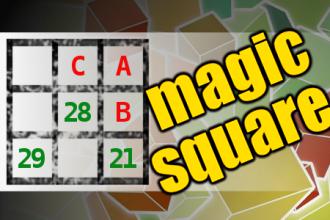MAGIC SQUARE: Calculate A+B*C
The aim is to place the some numbers from the list (21, 22, 24, 28, 29, 31, 57, 58, 60, 89) into the empty squares and squares marked with A, B an C. Sum of each row and column should be equal. All the numbers of the magic square must be different. Find values for A, B, and C. Solution is A+B*C.Correct answers: 29
The first user who solved this task is Allen Wager.
#brainteasers #math #magicsquare

Speeding Ticket
Cop pulls over a car with a couple in it.
"What's the problem officer?"
"Sir, you were going 68 in a 50-zone."
"What, that's ridiculous! I did no such thing!"
"Sir, I caught you with my radar gun, and it's always accurate, but I’ll give you some leeway and reduce it to 62.
"Well, not this time, asshole. I know I was doing 54! I'll take it to court, you son of a bitch!" The cop hands the man the ticket, and he rips it up.
"Sir, I'm going to have to insist you calm down, or I'll put you under arrest."
Suddenly, the wife interjects, "Mister, I wouldn't push it. There's no use arguing with him when he's drunk."

